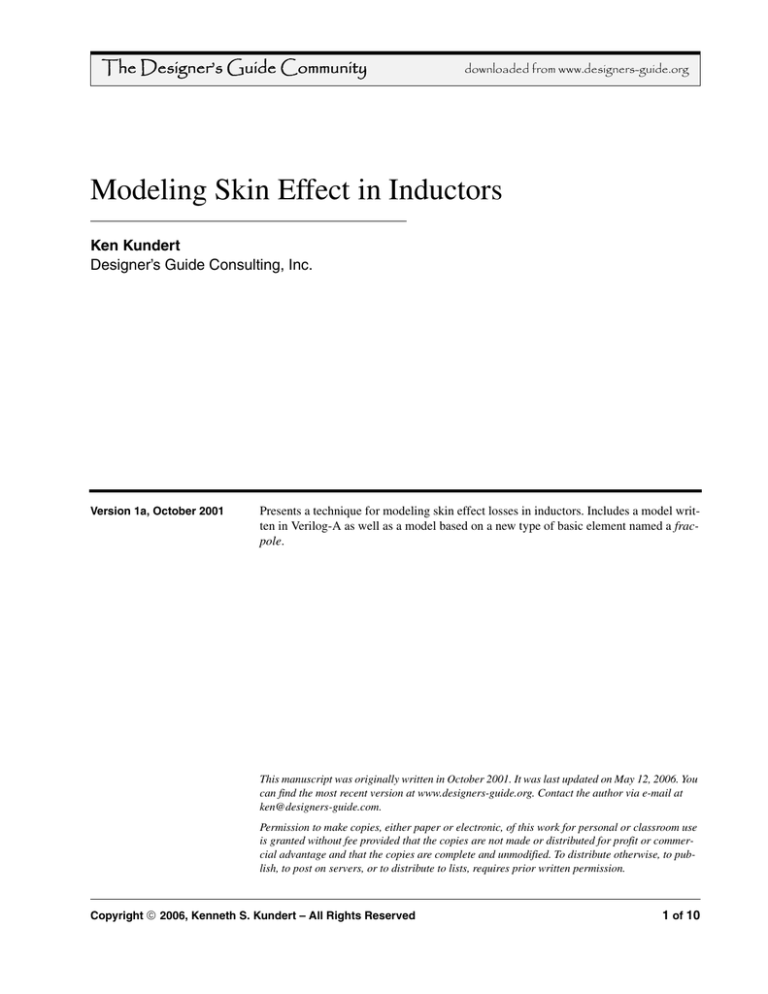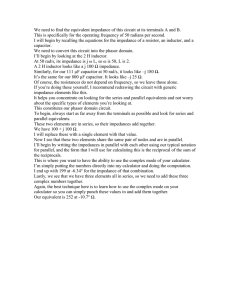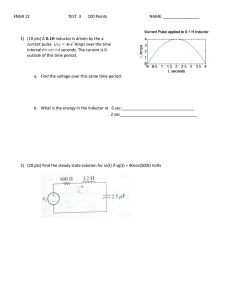
The Designer’s Guide Community
downloaded from www.designers-guide.org
Modeling Skin Effect in Inductors
Ken Kundert
Designer’s Guide Consulting, Inc.
Version 1a, October 2001
Presents a technique for modeling skin effect losses in inductors. Includes a model written in Verilog-A as well as a model based on a new type of basic element named a fracpole.
This manuscript was originally written in October 2001. It was last updated on May 12, 2006. You
can find the most recent version at www.designers-guide.org. Contact the author via e-mail at
ken@designers-guide.com.
Permission to make copies, either paper or electronic, of this work for personal or classroom use
is granted without fee provided that the copies are not made or distributed for profit or commercial advantage and that the copies are complete and unmodified. To distribute otherwise, to publish, to post on servers, or to distribute to lists, requires prior written permission.
Copyright © 2006, Kenneth S. Kundert – All Rights Reserved
1 of 10
Background
1.0 Background
In the Coilcraft application note on modeling RF inductors [2], the inductor is modeled
as shown in Figure 1. Component H in the model represents the skin-effect loss. In the
FIGURE 1.
RF inductor model.
Cp
Rp
H
L
Rs
ap-note, it is modeled in two different ways. In the PSPICE version, it is written as
( f )- = ----------------1 + jfZ( f ) = V
----------.
I( f )
H
(1)
For other simulation software, the model is written as
Z( f ) = k f .
(2)
These two models are not consistent in two ways. First, (1) has a corner at 1 Hz whereas
(2) does not. Second, Z( f ) in (1) is complex while in (2) it is real. Once significantly
above 1 Hz the real and imaginary are equal for the PSPICE model. Thus, for measurements made well above 1 Hz, k and H are related by
1
k = ----------2H
(3)
Having a purely real impedance that varies with f is not physically realizable (it
would be non-causal, as shown in the appendix) and so is clearly incorrect. However,
the corner frequency at 1 Hz in the PSPICE model seems artificial. I expect that it was
included to prevent the impedance from going to zero at DC, which causes problems for
PSPICE.
Instead of (1) and (2), skin effect is modeled here in a more traditional way,
jfZ( f ) = -------.
H
(4)
This model involves a non-integer power for f and so is a distributed model [1]. In other
words, Z( f ) cannot be exactly represented using a finite number of poles and zeros and
the model cannot be implemented exactly by combining a finite number of lumped components (resistors, capacitors, and inductors).
2.0 Modeling Skin Effect
A transfer function of jf is approximated over a finite range of frequencies with an
equal number of real poles and zeros alternating and evenly spaced in a logarithmic
2 of 10
The Designer’s Guide Community
www.designers-guide.org
Modeling Skin Effect
sense over that range, as shown in Figure 2. The range of the approximation is from f0 to
FIGURE 2.
Modeling the
jf nature of skin effect using a collection of real poles and zeros.
fz1 fp1 fz2 fp2 fz3 fp3 fz4 fp4 fz5 fp5
log Z
f1
m
f0
log f
f1, with the impedance flattening out at frequencies outside of this range. The range of
frequencies over which skin effect must be accurately modeled can be determined by
examining its contribution to the overall impedance of the inductor. The impedance of a
representative inductor is shown in Figure 3. Notice that the impedance is separated into
FIGURE 3.
Modeled impedance of an RF inductor separated into real (R) and imaginary (X) parts.
Coilcraft A01T Mini Spring
1kΩ
1/(2πfCp)
2πfL
100Ω
10Ω
1Ω
Rp
X
f
---------2H 2
100mΩ
10mΩ
R
1mΩ
Rs
10kHz 100kHz 1MHz 10MHz 100MHz 1GHz 10GHz 100GHz
its real and imaginary parts (the resistance and the reactance). The resistance represents
the loss. It is important to accurately model the resistive portion in the operating frequency range even where the reactive portion is much larger because it determines the Q
of resonators and because designer sometimes use tuning to cancel out the reactive portion.
Because we do not know the operating frequency range a priori, we must model the skin
effect over the range of frequencies where it is significant. The low frequency bound, f0,
is chosen to be the frequency where the impedance of the skin effect dominated over Rs.
The Designer’s Guide Community
www.designers-guide.org
3 of 10
Modeling Skin Effect
Since our lumped approximation of skin effect naturally flattens out at low frequency,
Rs will be combined with H to form HR as shown in Figure 4. Notice that the structure
FIGURE 4.
Modified RF inductor model.
Cp
Rp
L
HR
of the model was modified slightly to accommodate the combining of Rs and H. Since
Rp is always much larger than Rs, the difference is not expected to be significant.
The low frequency bound, f0, is the frequency where the resistance (the real part) of the
skin effect begins to dominate over Rs.
f0 = 2 ( Rs H )2
(5)
The high frequency bound, f1, is chosen to be the resonant frequency of LCp, because
above this frequency the capacitive path through the inductor dominate over the inductive path, and so Rp dominates over H.
1
f 1 = --------------------2π LC p
(6)
Placing f1 at the resonant frequency L and Cp does act to increase the modeled Q of this
parasitic resonance, but does not significantly affect the Q in the operating frequencies
of the inductor.
The number of lumps, n, is chosen to provide a sufficient level of accuracy. The larger n,
the closer the impedance of the lumped approximation matches jf . Typically, using
1½ lumps per decade of frequency range give a good fit (but 1 lump per decade is often
sufficient).
n =
f
3
--- log ---1
2 f0
(7)
The frequency span of one lump is then
m =
n
f
----1f0
(8)
From Figure 2, the zero and pole frequencies are simply
f zi = m
f pi = m
4 of 10
i–3
--4f
i–1
--4f
0
0
(9)
(10)
The Designer’s Guide Community
www.designers-guide.org
Verilog-A Inductor Model
with i ranging from 1 to n. For the inductor shown in Figure 3, impedance of the model
for just the skin effect is shown in Figure 5. In this example, f0 = 25 kHz and
FIGURE 5.
Impedance of skin effect model.
Skin Effect Portion of Coilcraft A01T Mini Spring Model
300mΩ
100mΩ
30mΩ
10mΩ
3mΩ
1mΩ
R
300uΩ
100uΩ
X
10kHz 100kHz 1MHz 10MHz 100MHz 1GHz 10GHz 100GHz
f1 = 65 GHz. It is clear that accuracy degrades at the ends of the range. If accuracy at the
ends is important, consider lowering f0 and/or raising f1 by and order of magnitude.
3.0 Verilog-A Inductor Model
A model is derived assuming that the Coilcraft parameter values are available. If they
are not, one can extract them graphically from measured data as illustrated in Figure 3.
The model of the inductor itself implements Figure 4 and is given in the form of a Verilog-A [4,7] netlist in Listing 1. It uses (5) and (6) to compute f0 and f1 for the skin effect
model. The parameter esr specifies Rs and rcp specifies Rp. Both H or k are parameters,
even though they specify the same thing. Just give one. Finally, the netlist used to test
the model is given in Listing 2.
Listing 3 shows the module that implements the skin effect model. It is based on (7), (8),
(9), and (10). The model starts by computing the location of the poles and zeros needed
to achieve the transfer function shown in Figure 2, and then implements the transfer
function using the laplace_zp function.
3.1 Results
Figure 6 shows the impedance exhibited by the model compared with measured data.
Both the model parameters and the measured s-parameter data are provided by Coilcraft
[2]. A large part of the discrepancy results either from a poor choice of model parameters or from poor s-parameter measurement technique (the odd shape of the s-parameter
data suggests that it is of questionable accuracy). For example, the s-parameter data suggests Rs = 80 mΩ, whereas Coilcraft specifies it as 1 mΩ. They may have provided Rs =
1 mΩ because DC measurements show this to be the value and they trust DC measurements more than s-parameter measurements at low frequencies and impedance levels
The Designer’s Guide Community
www.designers-guide.org
5 of 10
Verilog-A Inductor Model
LISTING 1.
Verilog-A model of the inductor.
‘include “discipline.h”
‘include”constants.h”
module lossy_ind(t1, t2);
electrical t1, t2;
parameter real esr=0.01 from (0:inf);
parameter real rcp=1.0 from (0:inf);
parameter real cp=10f from (0:inf);
parameter real l=1n from (0:inf);
parameter real k=1e–5 from (0:1);
parameter real h=1/(1.414∗k) from (1:inf);
electrical n1, n2;
resistor #(.r(rcp)) Rp (n2, t2);
skin_effect #(.r0(esr), .f0(2∗esr∗esr∗h∗h), .f1(1/(2∗‘M_PI∗sqrt(l∗cp)))) Hr (t1, n1);
capacitor #(.c(cp)) Cp (t1, n2);
inductor #(.l(l)) L (n1, t2);
endmodule
LISTING 2.
Spectre netlist used to test the inductor.
// test bench for inductor model with skin-effect
simulator lang=spectre
ahdl_include “lossy-inductor.va”
ahdl_include “skin-effect.va”
L1 (n 0) lossy_ind l=2.6nH esr=1m rcp=8 h=704k cp=230fF
I1 (n 0) isource mag=1
acswp ac start=10kHz stop=100GHz dec=20 title=“Coilcraft A01T Mini Spring”
(accuracy of s-parameters tend to degrade when impedance levels are far from the reference impedance of 50Ω). The loss modeling could be improved by decreasing H (or
increasing k) by a factor of 4. However, a substantial discrepancy will clearly remain
after correcting the parameter values because there is more detail in the measured data
than can be represented with this model.
3.2 Limitations of the Verilog-A Model
The model as implemented exhibits two annoying short comings. First, since it is implemented using the laplace_zp function, the noise produced by the inductor is not modeled. To accurately model noise, an RC equivalent to the skin effect model would have
to be synthesized.
Second, the number of lumps must be hard-coded in the model. There are two aspects of
Verilog-A that combine to create this limitation. First, laplace_zp determines the order
of the transfer function using the allocated size of the pole and zero arrays. Second,
when declaring an array, the size cannot depend on the value of a parameter; it must be a
6 of 10
The Designer’s Guide Community
www.designers-guide.org
Verilog-A Inductor Model
LISTING 3.
Verilog-A model of the skin effect.
‘include “discipline.h”
‘include”constants.h”
module skin_effect(p, n);
electrical p, n;
parameter real f0=1 from (0:inf);
parameter real f1=10 from (f0:inf);
parameter real r0=1 from (0:inf);
‘define lumps 10
real mult, mult2, wp, wz;
real zeros[0:2∗‘lumps–1], poles[0:2∗‘lumps–1];
integer i;
analog begin
@(initial_step(“static”)) begin
mult = pow(f1/f0, 1.0/(4∗‘lumps));
mult2 = mult∗mult;
wz = 2∗‘M_PI∗mult∗f0;
wp = mult2∗wz;
for (i=0; i < ‘lumps; i=i+1) begin
zeros[2∗i] = –wz;
zeros[2∗i+1] = 0;
poles[2∗i] = –wp;
poles[2∗i+1] = 0;
wz = mult2 ∗ wp;
wp = mult2 ∗ wz;
end
end
V(p,n) <+ r0∗laplace_zp( I(p,n), zeros, poles );
end
endmodule
FIGURE 6.
The measured impedance (Zd) of an RF inductor versus the impedance exhibited by the model
with vendor provide parameter values (Zm).
Coilcraft A01T Mini Spring
1kΩ
100Ω
10Ω
1Ω
100mΩ
Re{Zd}
Im{Zm}
10mΩ
Re{Zm}
1mΩ
10kHz
The Designer’s Guide Community
www.designers-guide.org
100kHz
Im{Zd}
1MHz 10MHz 100MHz
1GHz
10GHz
7 of 10
FracPole
constant. This constraint is a limitation of the current implementation of Verilog-A in
Spectre, and should be relaxed in future versions.
4.0 FracPole
The two issues with the Verilog-A model could be resolved if Spectre supported a new
type of basic element that exhibits the following impedance,
Z ( s ) = αs β .
(11)
As described before, if β is not an integer such a component is distributed and has time
constants that are spread over an infinite range, from infinitely long to infinitely short. In
a transient-based simulator, it must be approximated over a finite range of frequencies.
So, consider a new basic component type, named a fracpole, which is short for fractional impedance pole. It approximates (11) over the range of frequencies from f0 to f1.
Choose
1
α = --------------- ,
2πH
(12)
and β = ½. Doing so results in the over all impedance for the fracpole being
jf
Z ( f ) = ------.
H
(13)
A Spectre subcircuit implementation of the complete inductor model is given in Listing
4.
LISTING 4.
Inductor model.
simulator lang=spectre
subckt lossyind (1 2)
parameters l esr cp rp h f0 f1
L (1 3) inductor l=l
S (3 4) fracpole coef=1/sqrt(2∗M_PI)∗h slope=0.5 f0=f0 f1=f1 profile=dd
Cp (1 5) capacitor c=cp
Rp (5 4) resistor r=rp
Rs (4 2) resistor r=esr
ends lossyind
4.1 Interim Approach
Since the fracpole component is not yet available in Spectre, an alternative is available
on an interim basis. A program, separate from Spectre, is available that takes the fracpole parameters and generates a Spectre subcircuit that implements it [3]. This program
is limited to generating fracpoles with negative slope, so a gyrator would be needed to
effectively flip the sign of the slope. Also available is a program that takes a more direct
approach. It takes the Coilcraft parameters and uses the fracpole program to directly
generate a Spectre subcircuit description of the inductor of the form shown in Figure 1.
8 of 10
The Designer’s Guide Community
www.designers-guide.org
Appendix I
Appendix I
In this section, it is proved that the model of (2) is non-causal and therefore is not physically realizable.
Consider a system with frequency response H(ω). The impulse response is h(t).
Postulate that H(ω) is purely real. From this we conclude that h(t) is either zero for all t
≠ 0, or it is non-causal.
Proof: H(ω) = H(–ω) because of symmetry relations [h(t) must be real, implying H(ω)
= H(–ω)*, and H(ω) is real by assumption]. Consider Fourier transform pair:
H(ω) is real and even ⇔ h(t) is real and even.
therefore, either h(t) is zero for all t ≠ 0, which only occurs if H is independent of ω, or
h(t) is non-zero for t < 0, in other words, it is non-causal. ■
Incidentally, for specific case of
1
H ( ω ) ∼ -------ω
(14)
1
h ( t ) ∼ -------- .
t
(15)
This pair is found in tables of sine/cosine transforms.
Acknowledgements
I would like to thank Robert Tso of TelASIC Communications, Inc. for pointing out several small errors.
Prof. J. A. Tenreiro Machado has pointed out that the fracpole is an application of fractional calculus (FC) modeling, and that there is a well established community studying
FC and its applications (see IFAC workshop). He continued by saying that the algorithm
for modeling fractional poles with a collection of poles and zeros was first proposed by
A. Oustaloup some years ago [5].
References
An alternative approach to modeling skin effect is given in [6].
[1] L. O. Chua. Device modeling via basic nonlinear circuit elements. IEEE Transactions on Circuits and Systems, vol. CAS-27, no. 11, Nov. 1980.
[2] Modeling Coilcraft RF Inductors. Coilcraft document 158, May 1999, www.coilcraft.com.
[3] K. Kundert. The FracPole Suite. Available from www.designers-guide.org/Modeling. Includes executables and documentation.
The Designer’s Guide Community
www.designers-guide.org
9 of 10
References
[4] Kenneth S. Kundert. The Designer’s Guide to Verilog-AMS. Kluwer Academic
Publishers, 2004.
[5] A. Oustaloup, La Commande CRONE: Commande Robuste d’Ordre Non Entier,
Hermes, 1991.
[6] C. S. Yen, Z. Fazarinc, R. L. Wheeler. Time-domain skin-effect model for transient
analysis of lossy transmission lines. Proceedings of the IEEE, vol. 70, pp. 750-757,
July 1982.
[7] Verilog-AMS Language Reference Manual: Analog & Mixed-Signal Extensions to
Verilog HDL, version 2.1. Accellera, January 20, 2003. Available from www.accellera.com. An abridged version is available from www.verilog-ams.com or
www.designers-guide.org/VerilogAMS.
10 of 10
The Designer’s Guide Community
www.designers-guide.org





